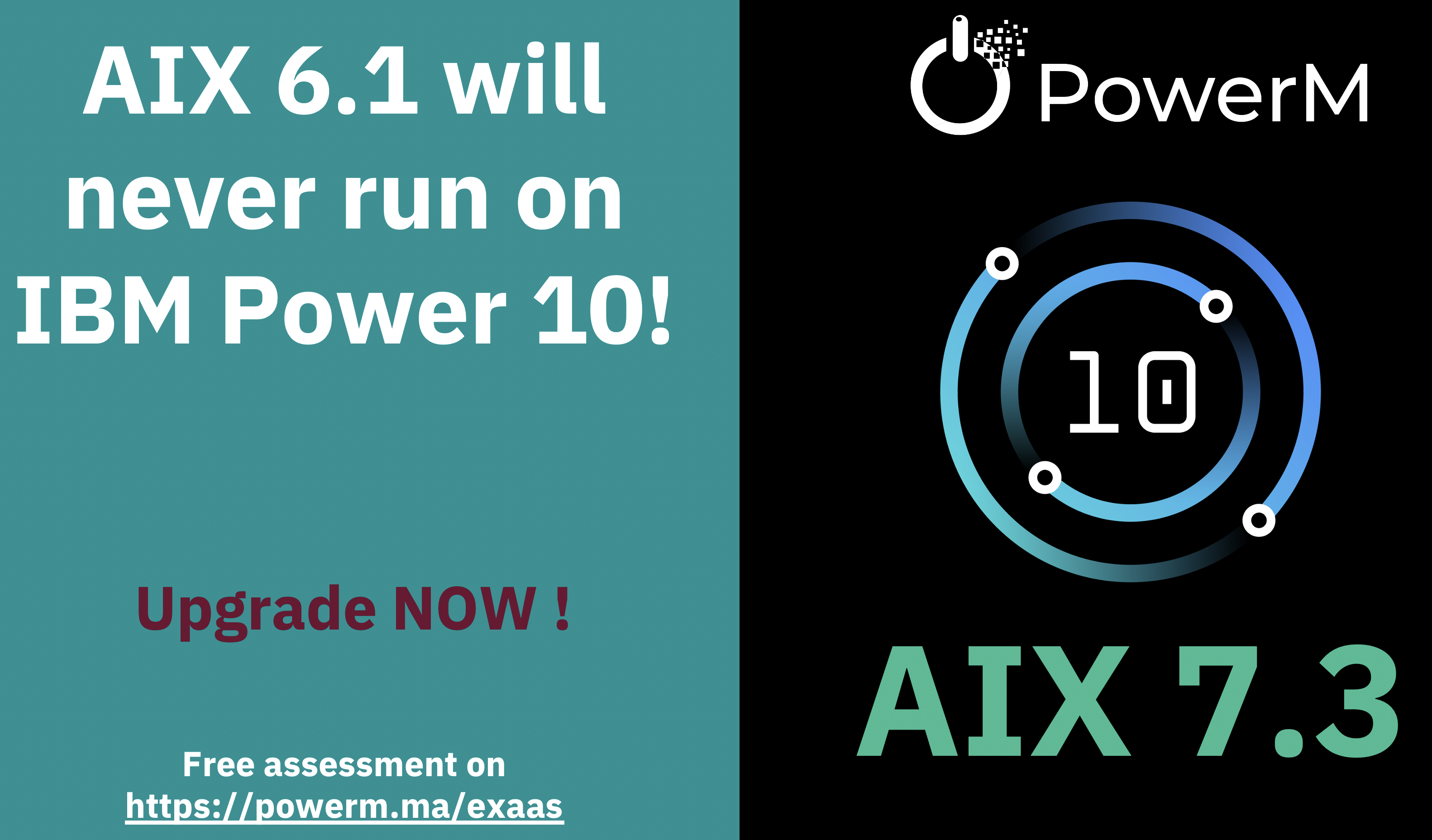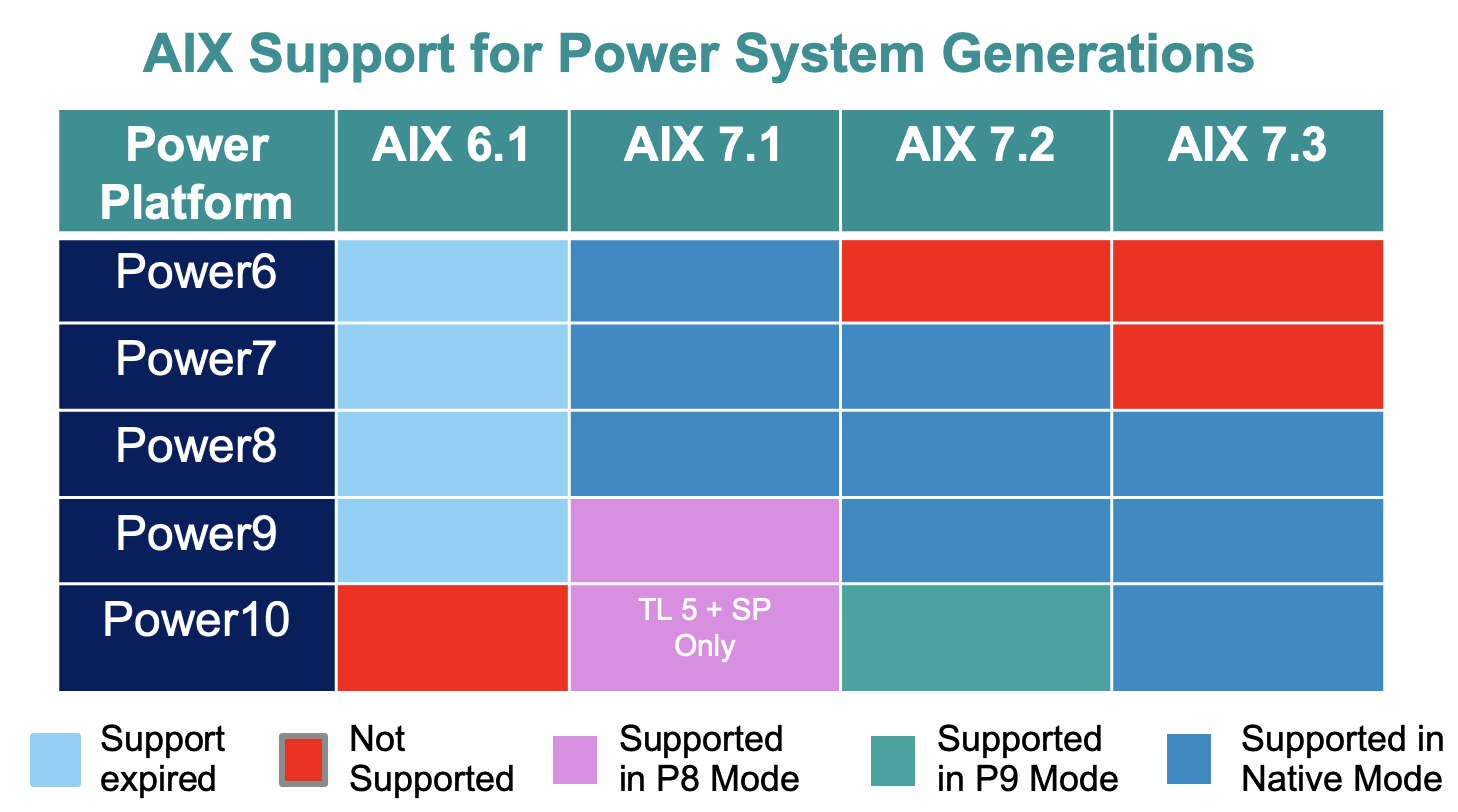
Upgrade IBM AIX 6.1 to 7.3: Do it now ! Sometimes ‘Later’ becomes ‘Never’ – Published 30 August 2022 – ID PM00322 – 3 min read
Abstract
There are a number of reasons why you choose to migrate away from legacy AIX 6.1 infrastructure. You find your existing Power 6,7,8 and software environment (Oracle 9i/10g) too costly to maintain and support. The high costs are often compounded by the lack of flexibility and agility, which can resultin additional costs due to lost business opportunity and an inability to respond to changing needs. You would like to move to a more flexible platform, but you still concerned about the cost and risk of migration. With rollout of IBM Power10 servers, you cannot afford running unsupported version of AIX anymore, you should migrate NOW to AIX 7.3 and the good news is that we can do it for you either on premise or using our existing Power managed services offering!
The Facts
Fact 1: AIX 6.1 will never run on ibm power 10
AIX 6.1 only runs un up to P7 mode while IBM Power10 supports P10, P9 and P8 mode.It’s not a matter of supporting , hypervisor will simply halts AIX 6.1 on boot !

Fact 2: No support, no service packs
After April 30, 2017, IBM is no longer providing generally available fixes or interim fixes on systems at AIX 6100-09.
AIX Technology Levels are supported for how to, usage, and problem identification for the entire life of the release. However, all Technology Levels have a limited support window for corrective service. If a fix is needed, you may be required to upgrade to a more current Technology Level to receive generally available fixes or interim fixes.
AIX 6.1 is now a legacy operating system:
- AIX 6.1 Latest Service Packs : Avril 2017 (LT9)
- AIX 6.1 EoSPS (EoS) : 30 April 2017
- AIX 6.1 Service Extension services : April 2020
Fact 3: your system is at the highest risk
There are no security updates for almost 5 years. Refer to the latest CVE list and check that available fixes and APAR are applied on your system.
PLAN - PRICE
Description
Denial of Service
13 x CVE
CVE-2016-0281 CVE-2014-0930 CVE-2013-3035 CVE-2012-2192 CVE-2012-4817 CVE-2012-0723 CVE-2012-0194 CVE-2011-3982 CVE-2011-1385 CVE-2011-1375 CVE-2011-0637 CVE-2009-4362 CVE-2009-4361
Unauthorized Access
36 x CVE
CVE-2016-6079 CVE-2016-0266 CVE-2015-4948 CVE-2014-8904 CVE-2014-3074 CVE-2013-5419 CVE-2013-4011 CVE-2013-3005 CVE-2013-2989 CVE-2012-4845 CVE-2012-4833 CVE-2012-2200 CVE-2012-2179 CVE-2012-0745 CVE-2011-1561 CVE-2011-1384 CVE-2010-3405 CVE-2010-1347 CVE-2010-1039 CVE-2010-0961 CVE-2010-0960 CVE-2009-3900 CVE-2009-2669 CVE-2009-1786 CVE-2009-1355 CVE-2009-0779 CVE-2008-2515 CVE-2008-2514 CVE-2008-2513 CVE-2008-1710 CVE-2008-1600 CVE-2008-1599 CVE-2008-1598 CVE-2008-1596 CVE-2008-0589 CVE-2008-0589 CVE-2007-6680 CVE-2007-5764
Root Privileges
6 x CVE
CVE-2018-1383 CVE-2018-1383 CVE-2017-1093 CVE-2016-8972 CVE-2016-6079 CVE-2015-5005
Memory Access
2 CVE
CVE-2018-1655 CVE-2008-1593
Fact 4: AIX Binary compatibility
AIX binary compatibility allows applications that were created on earlier releases or technology levels of AIX to run unchanged and without recompilation on later releases or technology levels of AIX.
The ability to run applications that were created on an earlier version of an operating system on a later level of the operating system is known as compatibility with an earlier version.
AIX 6.1 32-bit and 64-bit applications can run on AIX 7.3, without recompilation if the applications use portable programming techniques.
Fact 5: odds for SUCCESSFUL migration are near 100% until your are using some Oracle Pro*something programs without having source files
Migration from AIX6.1 to AIX7.3 are smooth and should run without any issues expect for the following situations:
- If your are using a Non-portable programming techniques (compilation by using a processor-specific compiler option but are run on models other than that processor, legacy security library interfaces in which long user names are enabled, Non-shared compiles of AIX-shared libraries,…) you should refer to AIX 7.3 Restrictions for AIX binary compatibility documentation.
- Many legacy applications that have embedded SQL code use the Oracle Pro*C and Pro*Cobol precompiled to access the database. This is the case of many PowerM’s customers in Morocco.Migrating Proc*C and Pro*Cobol from AIX 6.1 to 7.3 should work without major issues however, you should have source file since the odds of getting the source file (file.pc) having the executable are near zero. If you have an .exe you first need to get the C source code. You may get C source, but it will have the output of the ProC preprocessor ( calls to an Oracle API). Then you need a program to “decompile” yet again, this time from the .c file to the .pc file.
- Note : Pro*C and Pro*Cobol are an embedded SQL programming languages used by Oracle Database DBMSes. They uses either C/C++ and Cobol as their host language. During compilation, the embedded SQL statements are interpreted by a precompiler and replaced by C/C++or Cobol function calls to their respective SQL library. The output from the Pro*C and Pro*Cobol precompiler is standard C or C++ or Cobol code that is then compiled by any one of several C/C++ or Cobol compilers into an executable.
AIX 7.3 Migration Strategies and Tips
- You can migrate directly from AIX 6.1 to AIX 7.3
- Break mirroring on the root volume group before the migration begins
- Update the system FW to the latest level available on the download site
- Backup the system
- To move an existing LPAR to AIX 7.3 you must perform a migration install
- Traditional migration via ISO image, NIM, or nimadm
- update_all operations are not supported between version/release upgrades
- Make sure your system is ready to migrate: check for issues before migration by locally running /usr/lpp/bos/pre_migration that comes on the install media
- Take advantage of the AIX Migration Planning Workshop from PowerM ExaaS for Power offering
- AIX 7.3 has been tested with VIOS 3.1.x
- Upgrade you VIOS (2.6 reached end of life in 2020, 3.1.0 reaches end of life in November 2021)
Next steps
Book a consultation with a PowerM SME and use ExaaS for Power offering to upgrade your legacy AIX 6.1 to the latest version
References
- https://www-50.ibm.com/services/supline/products/ExtendedSupport/pSeries.pdf
- https://www.ibm.com/support/pages/aix-support-lifecycle-information
- https://www.oracle.com/fr/database/technologies/virtualization-matrix.html
- https://www.ibm.com/docs/en/aix/7.3?topic=aix-bos-pre-migration-post-migration-checks
- https://www.ibm.com/docs/en/aix/7.3?topic=compatibility-restrictions-aix-binary
- https://docs.oracle.com/en/database/oracle/oracle-database/19/pccrn/index.html#PCCRN-GUID-751C21E8-1E65-4D70-ABF2-C856F53FCA89
- https://docs.oracle.com/en/database/oracle/oracle-database/19/lnpcc/index.html
Disclaimer
This content was provided for informational purposes only. The opinions and insights discussed are mine and do not necessarily represent those of Power Maroc S.A.R.L.
Nothing contained in this article is intended to, nor shall have the effect of, creating any warranties or representations from Power Maroc S.A.R.L or its Partners (particularly IBM and Oracle), or altering the terms and conditions of any agreement you have with Power Maroc S.A.R.L

